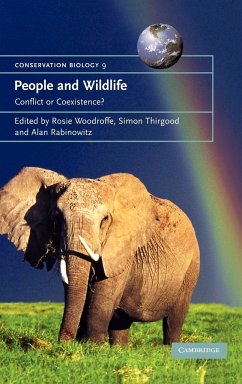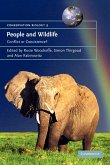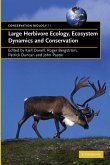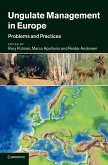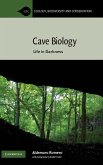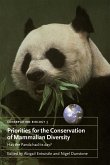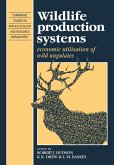Rosie Woodroffe / Simon Thirgood / Alan Rabinowitz (eds.)Conflict or Coexistence?
People and Wildlife
Conflict or Coexistence?
Herausgeber: Woodroffe, Rosie; Rabinowitz, Alan; Thirgood, Simon
Rosie Woodroffe / Simon Thirgood / Alan Rabinowitz (eds.)Conflict or Coexistence?
People and Wildlife
Conflict or Coexistence?
Herausgeber: Woodroffe, Rosie; Rabinowitz, Alan; Thirgood, Simon
- Gebundenes Buch
- Merkliste
- Auf die Merkliste
- Bewerten Bewerten
- Teilen
- Produkt teilen
- Produkterinnerung
- Produkterinnerung
This book discusses whether, and how, coexistence of people and endangered wildlife may be encouraged.
Andere Kunden interessierten sich auch für
![People and Wildlife People and Wildlife]() Rosie Woodroffe / Simon Thirgood / Alan Rabinowitz (eds.)People and Wildlife87,99 €
Rosie Woodroffe / Simon Thirgood / Alan Rabinowitz (eds.)People and Wildlife87,99 €![Large Herbivore Ecology, Ecosystem Dynamics and Conservation Large Herbivore Ecology, Ecosystem Dynamics and Conservation]() Kjell Danell / Roger Bergström / Patrick Duncan / John Pastor / Han Olff (eds.)Large Herbivore Ecology, Ecosystem Dynamics and Conservation95,99 €
Kjell Danell / Roger Bergström / Patrick Duncan / John Pastor / Han Olff (eds.)Large Herbivore Ecology, Ecosystem Dynamics and Conservation95,99 €![Ungulate Management in Europe Ungulate Management in Europe]() Ungulate Management in Europe162,99 €
Ungulate Management in Europe162,99 €![Cave Biology Cave Biology]() Aldemaro RomeroCave Biology179,99 €
Aldemaro RomeroCave Biology179,99 €![Defending Biodiversity Defending Biodiversity]() Jonathan A. NewmanDefending Biodiversity51,99 €
Jonathan A. NewmanDefending Biodiversity51,99 €![Priorities for the Conservation of Mammalian Diversity Priorities for the Conservation of Mammalian Diversity]() Abigail Entwistle / Nigel Dunstone (eds.)Priorities for the Conservation of Mammalian Diversity101,99 €
Abigail Entwistle / Nigel Dunstone (eds.)Priorities for the Conservation of Mammalian Diversity101,99 €![Wildlife Production Systems Wildlife Production Systems]() R. J. HudsonWildlife Production Systems69,99 €
R. J. HudsonWildlife Production Systems69,99 €-
-
-
This book discusses whether, and how, coexistence of people and endangered wildlife may be encouraged.
Hinweis: Dieser Artikel kann nur an eine deutsche Lieferadresse ausgeliefert werden.
Hinweis: Dieser Artikel kann nur an eine deutsche Lieferadresse ausgeliefert werden.
Produktdetails
- Produktdetails
- Verlag: Cambridge University Press
- Seitenzahl: 516
- Erscheinungstermin: 10. März 2009
- Englisch
- Abmessung: 240mm x 161mm x 32mm
- Gewicht: 933g
- ISBN-13: 9780521825054
- ISBN-10: 0521825059
- Artikelnr.: 21545817
- Herstellerkennzeichnung
- Libri GmbH
- Europaallee 1
- 36244 Bad Hersfeld
- gpsr@libri.de
- Verlag: Cambridge University Press
- Seitenzahl: 516
- Erscheinungstermin: 10. März 2009
- Englisch
- Abmessung: 240mm x 161mm x 32mm
- Gewicht: 933g
- ISBN-13: 9780521825054
- ISBN-10: 0521825059
- Artikelnr.: 21545817
- Herstellerkennzeichnung
- Libri GmbH
- Europaallee 1
- 36244 Bad Hersfeld
- gpsr@libri.de
Rosie Woodroffe is Assistant Professor of Conservation Biology at the University of California, Davis.
Foreword John G. Robinson; 1. The impact of human-wildlife conflict on
natural systems Rosie Woodroffe, Simon Thirgood and Alan Rabinowitz; 2. The
impact of human-wildlife conflict on human lives and livelihoods Simon
Thirgood, Rosie Woodroffe and Alan Rabinowitz; 3. Characterisation and
prevention of attacks on humans Howard Quigley and Stephen Herrero; 4.
Non-lethal techniques for reducing depredation Urs Breitenmoser, Christof
Angst, Jean-Marc Landry, Christine Breitenmoser-Wursten, John D. C. Linnell
and Jean-Marc Weber; 5. Techniques to reduce crop loss: human and technical
dimensions in Africa F. V. Osborn and C. M. Hill; 6. Evaluating lethal
control in the management of human-wildlife conflict Adrian Treves and Lisa
Naughton-Treves; 7. Bearing the cost of human-wildlife conflict: the
challenges of compensation schemes Philip J. Nyhus, Steven A. Osofsky, Paul
Ferraro, Francine Madden and Hank Fischer; 8. Increasing the value of
wildlife through non-consumptive use? Deconstructing the myths of
ecotourism and community-based tourism in the tropics M. J. Walpole and C.
R. Thouless; 9. Does extractive use provide opportunities to offset
conflicts between people and wildlife? N. Leader-Williams and J. M. Hutton;
10. Zoning as a means of mitigating conflicts with large carnivores:
principles and reality John D. C. Linnell, Erlend Birkeland Nilsen, Unni
Stobet Lande, Ivar Herfindal, John Odden, Ketil Skogen, Reidar Andersen and
Urs Breitenmoser; 11. From conflict to coexistence: a case study of geese
and agriculture in Scotland David Cope, Juliet Vickery and Marcus
Rowcliffe; 12. Hen harriers and red grouse: the ecology of a conflict Simon
Thirgood and Steve Redpath; 13. Understanding and resolving the
black-tailed prairie dog conservation challenge Richard P. Reading, Lauren
McCain, Tim W. Clark and Brian J. Miller; 14. People and elephants in
Shimba Hills, Kenya Timothy J. Knickerbocker and John Waithaka; 15. Safari
hunting and conservation on communal land in southern Africa Dale Lewis and
John Jackson; 16. Socioecological factors shaping local support for
wildlife: crop raiding by elephants and other wildlife in Africa Lisa
Naughton-Treves and Adrian Treves; 17. Jaguars and livestock: living with
the world's third largest cat Alan Rabinowitz; 18. People and predators in
Laikipia District, Kenya Laurence G. Frank, Rosie Woodroffe and Mordecai O.
Ogada; 19. Searching for the coexistence recipe: a case study of conflicts
between people and tigers in the Russian far east Dale Miquelle, Igor
Nikolaev, John Goodrich, Boris Litvinov, Evgeny Smirnov and Evgeny Suvorov;
20. A tale of two countries: large carnivore depredations and compensation
schemes in Sweden and Norway Jon E. Swenson and Henrik Andren; 21. Managing
wolf-human conflict in the northwestern United States Edward E. Bangs,
Joseph A. Fontaine, Michael D. Jimenez, Thomas J. Meier, Elizabeth H.
Bradley, Carter C. Niemeyer, Douglas W. Smith, Curt M. Mack, Val Asher and
John K. Oakleaf; 22. Policies for reducing human-wildlife conflict: a Kenya
case study David Western and John Waithaka; 23. An ecology-based policy
framework for human-tiger coexistence in India K. Ullas Karanth and Rajesh
Gopal; 24. The future of coexistence: resolving human-wildlife conflicts in
a changing world Rosie Woodroffe, Simon Thirgood and Alan Rabinowitz.
natural systems Rosie Woodroffe, Simon Thirgood and Alan Rabinowitz; 2. The
impact of human-wildlife conflict on human lives and livelihoods Simon
Thirgood, Rosie Woodroffe and Alan Rabinowitz; 3. Characterisation and
prevention of attacks on humans Howard Quigley and Stephen Herrero; 4.
Non-lethal techniques for reducing depredation Urs Breitenmoser, Christof
Angst, Jean-Marc Landry, Christine Breitenmoser-Wursten, John D. C. Linnell
and Jean-Marc Weber; 5. Techniques to reduce crop loss: human and technical
dimensions in Africa F. V. Osborn and C. M. Hill; 6. Evaluating lethal
control in the management of human-wildlife conflict Adrian Treves and Lisa
Naughton-Treves; 7. Bearing the cost of human-wildlife conflict: the
challenges of compensation schemes Philip J. Nyhus, Steven A. Osofsky, Paul
Ferraro, Francine Madden and Hank Fischer; 8. Increasing the value of
wildlife through non-consumptive use? Deconstructing the myths of
ecotourism and community-based tourism in the tropics M. J. Walpole and C.
R. Thouless; 9. Does extractive use provide opportunities to offset
conflicts between people and wildlife? N. Leader-Williams and J. M. Hutton;
10. Zoning as a means of mitigating conflicts with large carnivores:
principles and reality John D. C. Linnell, Erlend Birkeland Nilsen, Unni
Stobet Lande, Ivar Herfindal, John Odden, Ketil Skogen, Reidar Andersen and
Urs Breitenmoser; 11. From conflict to coexistence: a case study of geese
and agriculture in Scotland David Cope, Juliet Vickery and Marcus
Rowcliffe; 12. Hen harriers and red grouse: the ecology of a conflict Simon
Thirgood and Steve Redpath; 13. Understanding and resolving the
black-tailed prairie dog conservation challenge Richard P. Reading, Lauren
McCain, Tim W. Clark and Brian J. Miller; 14. People and elephants in
Shimba Hills, Kenya Timothy J. Knickerbocker and John Waithaka; 15. Safari
hunting and conservation on communal land in southern Africa Dale Lewis and
John Jackson; 16. Socioecological factors shaping local support for
wildlife: crop raiding by elephants and other wildlife in Africa Lisa
Naughton-Treves and Adrian Treves; 17. Jaguars and livestock: living with
the world's third largest cat Alan Rabinowitz; 18. People and predators in
Laikipia District, Kenya Laurence G. Frank, Rosie Woodroffe and Mordecai O.
Ogada; 19. Searching for the coexistence recipe: a case study of conflicts
between people and tigers in the Russian far east Dale Miquelle, Igor
Nikolaev, John Goodrich, Boris Litvinov, Evgeny Smirnov and Evgeny Suvorov;
20. A tale of two countries: large carnivore depredations and compensation
schemes in Sweden and Norway Jon E. Swenson and Henrik Andren; 21. Managing
wolf-human conflict in the northwestern United States Edward E. Bangs,
Joseph A. Fontaine, Michael D. Jimenez, Thomas J. Meier, Elizabeth H.
Bradley, Carter C. Niemeyer, Douglas W. Smith, Curt M. Mack, Val Asher and
John K. Oakleaf; 22. Policies for reducing human-wildlife conflict: a Kenya
case study David Western and John Waithaka; 23. An ecology-based policy
framework for human-tiger coexistence in India K. Ullas Karanth and Rajesh
Gopal; 24. The future of coexistence: resolving human-wildlife conflicts in
a changing world Rosie Woodroffe, Simon Thirgood and Alan Rabinowitz.
Foreword John G. Robinson; 1. The impact of human-wildlife conflict on
natural systems Rosie Woodroffe, Simon Thirgood and Alan Rabinowitz; 2. The
impact of human-wildlife conflict on human lives and livelihoods Simon
Thirgood, Rosie Woodroffe and Alan Rabinowitz; 3. Characterisation and
prevention of attacks on humans Howard Quigley and Stephen Herrero; 4.
Non-lethal techniques for reducing depredation Urs Breitenmoser, Christof
Angst, Jean-Marc Landry, Christine Breitenmoser-Wursten, John D. C. Linnell
and Jean-Marc Weber; 5. Techniques to reduce crop loss: human and technical
dimensions in Africa F. V. Osborn and C. M. Hill; 6. Evaluating lethal
control in the management of human-wildlife conflict Adrian Treves and Lisa
Naughton-Treves; 7. Bearing the cost of human-wildlife conflict: the
challenges of compensation schemes Philip J. Nyhus, Steven A. Osofsky, Paul
Ferraro, Francine Madden and Hank Fischer; 8. Increasing the value of
wildlife through non-consumptive use? Deconstructing the myths of
ecotourism and community-based tourism in the tropics M. J. Walpole and C.
R. Thouless; 9. Does extractive use provide opportunities to offset
conflicts between people and wildlife? N. Leader-Williams and J. M. Hutton;
10. Zoning as a means of mitigating conflicts with large carnivores:
principles and reality John D. C. Linnell, Erlend Birkeland Nilsen, Unni
Stobet Lande, Ivar Herfindal, John Odden, Ketil Skogen, Reidar Andersen and
Urs Breitenmoser; 11. From conflict to coexistence: a case study of geese
and agriculture in Scotland David Cope, Juliet Vickery and Marcus
Rowcliffe; 12. Hen harriers and red grouse: the ecology of a conflict Simon
Thirgood and Steve Redpath; 13. Understanding and resolving the
black-tailed prairie dog conservation challenge Richard P. Reading, Lauren
McCain, Tim W. Clark and Brian J. Miller; 14. People and elephants in
Shimba Hills, Kenya Timothy J. Knickerbocker and John Waithaka; 15. Safari
hunting and conservation on communal land in southern Africa Dale Lewis and
John Jackson; 16. Socioecological factors shaping local support for
wildlife: crop raiding by elephants and other wildlife in Africa Lisa
Naughton-Treves and Adrian Treves; 17. Jaguars and livestock: living with
the world's third largest cat Alan Rabinowitz; 18. People and predators in
Laikipia District, Kenya Laurence G. Frank, Rosie Woodroffe and Mordecai O.
Ogada; 19. Searching for the coexistence recipe: a case study of conflicts
between people and tigers in the Russian far east Dale Miquelle, Igor
Nikolaev, John Goodrich, Boris Litvinov, Evgeny Smirnov and Evgeny Suvorov;
20. A tale of two countries: large carnivore depredations and compensation
schemes in Sweden and Norway Jon E. Swenson and Henrik Andren; 21. Managing
wolf-human conflict in the northwestern United States Edward E. Bangs,
Joseph A. Fontaine, Michael D. Jimenez, Thomas J. Meier, Elizabeth H.
Bradley, Carter C. Niemeyer, Douglas W. Smith, Curt M. Mack, Val Asher and
John K. Oakleaf; 22. Policies for reducing human-wildlife conflict: a Kenya
case study David Western and John Waithaka; 23. An ecology-based policy
framework for human-tiger coexistence in India K. Ullas Karanth and Rajesh
Gopal; 24. The future of coexistence: resolving human-wildlife conflicts in
a changing world Rosie Woodroffe, Simon Thirgood and Alan Rabinowitz.
natural systems Rosie Woodroffe, Simon Thirgood and Alan Rabinowitz; 2. The
impact of human-wildlife conflict on human lives and livelihoods Simon
Thirgood, Rosie Woodroffe and Alan Rabinowitz; 3. Characterisation and
prevention of attacks on humans Howard Quigley and Stephen Herrero; 4.
Non-lethal techniques for reducing depredation Urs Breitenmoser, Christof
Angst, Jean-Marc Landry, Christine Breitenmoser-Wursten, John D. C. Linnell
and Jean-Marc Weber; 5. Techniques to reduce crop loss: human and technical
dimensions in Africa F. V. Osborn and C. M. Hill; 6. Evaluating lethal
control in the management of human-wildlife conflict Adrian Treves and Lisa
Naughton-Treves; 7. Bearing the cost of human-wildlife conflict: the
challenges of compensation schemes Philip J. Nyhus, Steven A. Osofsky, Paul
Ferraro, Francine Madden and Hank Fischer; 8. Increasing the value of
wildlife through non-consumptive use? Deconstructing the myths of
ecotourism and community-based tourism in the tropics M. J. Walpole and C.
R. Thouless; 9. Does extractive use provide opportunities to offset
conflicts between people and wildlife? N. Leader-Williams and J. M. Hutton;
10. Zoning as a means of mitigating conflicts with large carnivores:
principles and reality John D. C. Linnell, Erlend Birkeland Nilsen, Unni
Stobet Lande, Ivar Herfindal, John Odden, Ketil Skogen, Reidar Andersen and
Urs Breitenmoser; 11. From conflict to coexistence: a case study of geese
and agriculture in Scotland David Cope, Juliet Vickery and Marcus
Rowcliffe; 12. Hen harriers and red grouse: the ecology of a conflict Simon
Thirgood and Steve Redpath; 13. Understanding and resolving the
black-tailed prairie dog conservation challenge Richard P. Reading, Lauren
McCain, Tim W. Clark and Brian J. Miller; 14. People and elephants in
Shimba Hills, Kenya Timothy J. Knickerbocker and John Waithaka; 15. Safari
hunting and conservation on communal land in southern Africa Dale Lewis and
John Jackson; 16. Socioecological factors shaping local support for
wildlife: crop raiding by elephants and other wildlife in Africa Lisa
Naughton-Treves and Adrian Treves; 17. Jaguars and livestock: living with
the world's third largest cat Alan Rabinowitz; 18. People and predators in
Laikipia District, Kenya Laurence G. Frank, Rosie Woodroffe and Mordecai O.
Ogada; 19. Searching for the coexistence recipe: a case study of conflicts
between people and tigers in the Russian far east Dale Miquelle, Igor
Nikolaev, John Goodrich, Boris Litvinov, Evgeny Smirnov and Evgeny Suvorov;
20. A tale of two countries: large carnivore depredations and compensation
schemes in Sweden and Norway Jon E. Swenson and Henrik Andren; 21. Managing
wolf-human conflict in the northwestern United States Edward E. Bangs,
Joseph A. Fontaine, Michael D. Jimenez, Thomas J. Meier, Elizabeth H.
Bradley, Carter C. Niemeyer, Douglas W. Smith, Curt M. Mack, Val Asher and
John K. Oakleaf; 22. Policies for reducing human-wildlife conflict: a Kenya
case study David Western and John Waithaka; 23. An ecology-based policy
framework for human-tiger coexistence in India K. Ullas Karanth and Rajesh
Gopal; 24. The future of coexistence: resolving human-wildlife conflicts in
a changing world Rosie Woodroffe, Simon Thirgood and Alan Rabinowitz.

